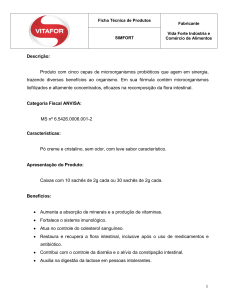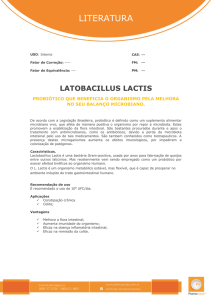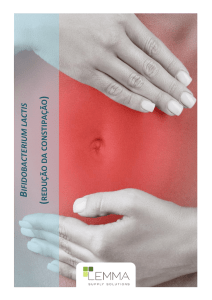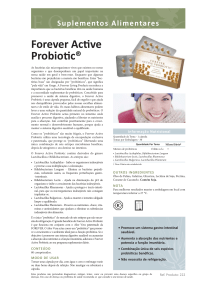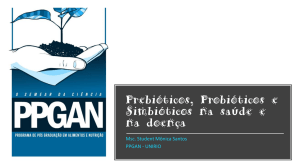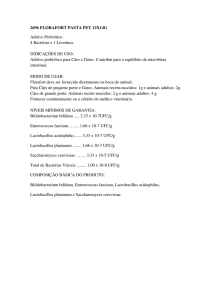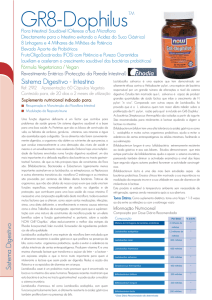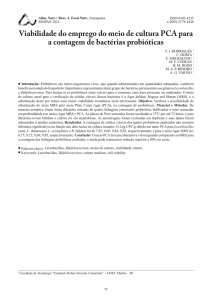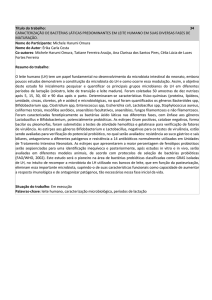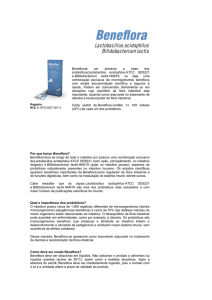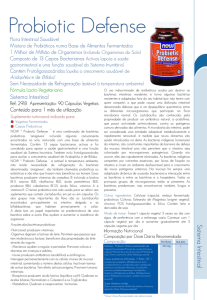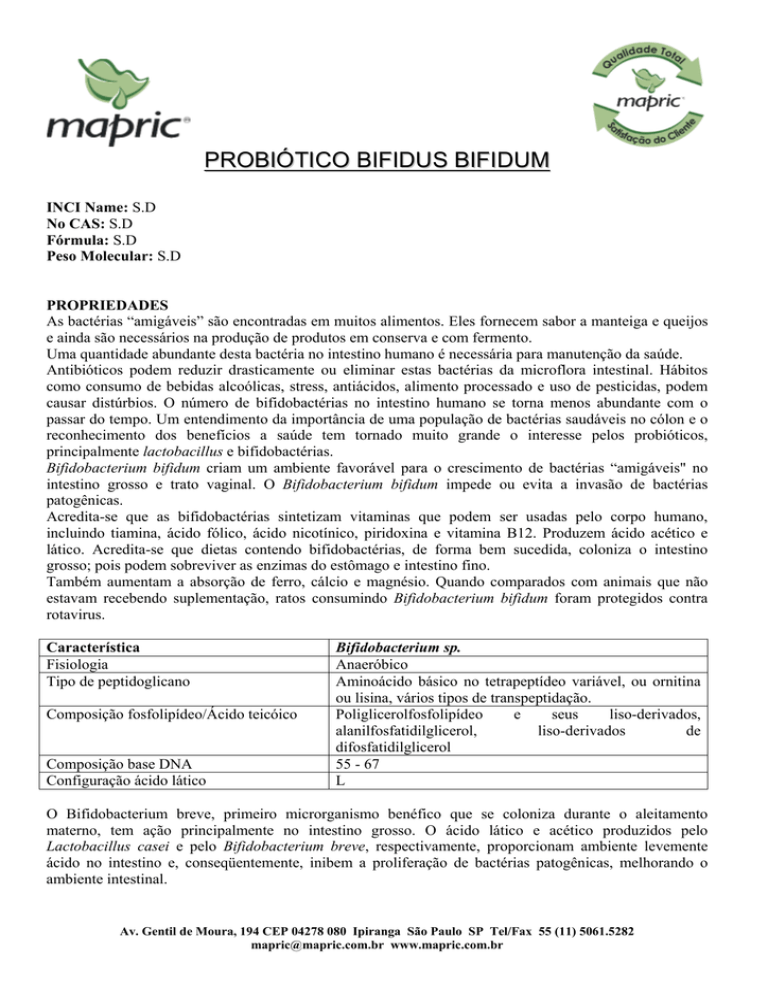
PROBIÓTICO BIFIDUS BIFIDUM
INCI Name: S.D
No CAS: S.D
Fórmula: S.D
Peso Molecular: S.D
PROPRIEDADES
As bactérias “amigáveis” são encontradas em muitos alimentos. Eles fornecem sabor a manteiga e queijos
e ainda são necessários na produção de produtos em conserva e com fermento.
Uma quantidade abundante desta bactéria no intestino humano é necessária para manutenção da saúde.
Antibióticos podem reduzir drasticamente ou eliminar estas bactérias da microflora intestinal. Hábitos
como consumo de bebidas alcoólicas, stress, antiácidos, alimento processado e uso de pesticidas, podem
causar distúrbios. O número de bifidobactérias no intestino humano se torna menos abundante com o
passar do tempo. Um entendimento da importância de uma população de bactérias saudáveis no cólon e o
reconhecimento dos benefícios a saúde tem tornado muito grande o interesse pelos probióticos,
principalmente lactobacillus e bifidobactérias.
Bifidobacterium bifidum criam um ambiente favorável para o crescimento de bactérias “amigáveis" no
intestino grosso e trato vaginal. O Bifidobacterium bifidum impede ou evita a invasão de bactérias
patogênicas.
Acredita-se que as bifidobactérias sintetizam vitaminas que podem ser usadas pelo corpo humano,
incluindo tiamina, ácido fólico, ácido nicotínico, piridoxina e vitamina B12. Produzem ácido acético e
lático. Acredita-se que dietas contendo bifidobactérias, de forma bem sucedida, coloniza o intestino
grosso; pois podem sobreviver as enzimas do estômago e intestino fino.
Também aumentam a absorção de ferro, cálcio e magnésio. Quando comparados com animais que não
estavam recebendo suplementação, ratos consumindo Bifidobacterium bifidum foram protegidos contra
rotavirus.
Característica
Fisiologia
Tipo de peptidoglicano
Composição fosfolipídeo/Ácido teicóico
Composição base DNA
Configuração ácido lático
Bifidobacterium sp.
Anaeróbico
Aminoácido básico no tetrapeptídeo variável, ou ornitina
ou lisina, vários tipos de transpeptidação.
Poliglicerolfosfolipídeo
e
seus
liso-derivados,
alanilfosfatidilglicerol,
liso-derivados
de
difosfatidilglicerol
55 - 67
L
O Bifidobacterium breve, primeiro microrganismo benéfico que se coloniza durante o aleitamento
materno, tem ação principalmente no intestino grosso. O ácido lático e acético produzidos pelo
Lactobacillus casei e pelo Bifidobacterium breve, respectivamente, proporcionam ambiente levemente
ácido no intestino e, conseqüentemente, inibem a proliferação de bactérias patogênicas, melhorando o
ambiente intestinal.
Av. Gentil de Moura, 194 CEP 04278 080 Ipiranga São Paulo SP Tel/Fax 55 (11) 5061.5282
[email protected] www.mapric.com.br
INDICAÇÃO
Os probióticos aumentam de maneira significativa o valor nutritivo e terapêutico dos alimentos porque há
um aumento dos níveis de vitaminas do complexo B e aminoácidos. Absorção acrescida de cálcio e ferro;
fortalecimento do sistema imunológico, através de uma maior produção de células protetoras.
O produto possibilita melhora do trânsito intestinal, normalização da consistência fecal, diminuição do
número de evacuações em casos de diarréia, regularização dos transtornos gastrintestinais e maior
combate das bactérias nocivas no intestino.
Av. Gentil de Moura, 194 CEP 04278 080 Ipiranga São Paulo SP Tel/Fax 55 (11) 5061.5282
[email protected] www.mapric.com.br
EFEITOS BENÉFICOS
• Redução do pH intestinal;
• Influência positiva na flora intestinal: inibe crescimento de patogênicos e putrefativos e protege
contra infecções intestinais;
• Melhora do funcionamento intestinal: elimina constipação leve;
• Redução do colesterol;
• Aumento da tolerância e digestão da lactose;
• Produz vitaminas do complexo B, ácido fólico;
• Redução de amônia e outros compostos tóxicos;
• Estimulação de respostas do sistema imunológico: imunomoduladoras - ação contra células
malignas;
• Restauração da flora intestinal normal após uso de antibióticos – balanceamento da flora
especialmente em crianças e idosos: tratamento e prevenção de diarréia aguda causada por
rotavírus em crianças; inibição de crescimento e adesão de enteropatógenos.
ARMAZENAMENTO
Conservar em geladeira, em temperatura igual ou menor que 4°C.
REFERÊNCIAS BIBLIOGRÁFICAS
1- Aguirre, M. and M.D. Collins. 1993. Lactic acid bacteria and human clinical infections. J. Appl. Bact.
75:95- 107.
2- Arunachalam K, Gill HS, Chandra RK. Enhancement of natural immune function by dietary
consumption of Bifi dobacterium lactis (HN019). Eur J Clin Nutr 2000; 54:263-267.
3- Bernet, M.F., Brassart, D., Neeser, J.R., and A.L. Servin. 1993. Adhesion of human bifidobacterial
strains to cultured human intestinal epithelial cells and inhibition of enteropathogen-cell interactions.
Appl. Environ. Microbiol. 59(12):4121-4128.
4- Borriello, S.P., Hammes, W.P., Holzapfel, W., Marteau, P., Schrezenmeir, J., Vaara, M., and V.
Valtonen. 2003. Safety of probiotics that contain lactobacilli or bifidobacteria. Clin. Infect Dis. 36:775780.
5- Bouhnik, Y., Pochart, P., Marteau, P., Arlet, G., Goderel, I., and J.C. Rambaud. 1992. Fecal recovery in
humans of viable Bifidobacterium sp. ingested in fermented milk. Gastroenterology. 102(3):875-878.
6- Cai, Y., Matsumoto, M., and Y. Benno. 2000. Bifidobacterium lactis Meile et. Al. 1997 is a subjective
synonym of Bifidobacterium animalis (Mitsuoka 1969) Scardovi and Trovatelli 1974. Microbiol.
Immunol. 44:815-820.
7- Chiang BL, Sheih YH, Wang LH, Liao CK, Gill HS. Enhancing immunity by dietary consumption of a
probiotic lactic acid bacterium (Bifi dobacterium lactis HN019): optimization and definition of cellular
immune responses. Eur J Clin Nutr 2000; 54:849-855.
8- Diplock AT, Aggett PJ, Ashwell M, Bornet F, E.B. F, Roberfroid MB. Scientifi c concepts of
functional foods in Europe:Consensus document. Br J Nutr 1999; 81(Suppl 1):S1-S27.
9- Dunne C, O’Mahony L, Murphy L, Thornton G, Morrissey D, O’Halloran S et al. In vitro selection
criteria for probiotic bacteria of human origin: correlation with in vivo fi ndings. Am J Clin Nutr 2001;
73:386S-392S.
10- Führ C. Überleben von probiotischen Keimen im Gastrointestinaltrakt (in vitro Versuche). 1998.
Diplomarbeit, Fachhochschule Jena, Germany.
11- Gasser, F. 1994. Safety of lactic acid bacteria and their occurrence in human clinical infections. Bull
Inst Pasteur 92: 45-67.
Av. Gentil de Moura, 194 CEP 04278 080 Ipiranga São Paulo SP Tel/Fax 55 (11) 5061.5282
[email protected] www.mapric.com.br
12- Gill HS. Potential of using dietary lactic acid bacteria for enhancement of immunity. Dialogue 1999;
32(11):6-11.
13- Gill HS, Rutherfurd KJ, Prasad J, Gopal PK. Enhancement of natural and acquired immunity by
Lactobacillus rhamnosus (HN001), Lactobacillus acidophilus (HN017) and Bifi dobacterium lactis
(HN019). Br J Nutr 2000; 83:167-176.
14- Gill H, Rutherfurd KJ, Cross ML. Dietary probiotic supplementation enhances natural killer cell
activity in the elderly: an investigation of age-related immunological changes. J Clin Immunol 2001;
21(4):264-271.
15- Gill H, Rutherfurd KJ, Cross ML, Gopal PK. Enhancement of immunity in the elderly by dietary
supplementation with the probiotic Bifi dobacterium lactis HN019. Am J Clin Nutr 2001; 74(6):833- 839.
16- Gill, H.S., Rutherfurd, K.J., Cross, M.L., and P.K. Gopal. 2001. Enhancement of immunity in the
elderly by dietary supplementation with the probiotic Bifidobacterium lactis HN019. Am J Clin Nutr.
74(6):833-839.
17- Gopal PK, Prasad J, Smart J, Gill HS. In vitro adherence properties of Lactobacillus rhamnosus DR20
and Bifi dobacterium lactis DR10 strains and their antagonistic activity against an enterotoxigenic
Escherichia coli . Int J Food Microbiol 2001; 67:207-216.
18- Gopal P, Prasad J, Gill HS. Effects of the consumption of Bifi dobacterium lactis HN019 (DR10TM)
and galactooligosaccharides on the microfl ora of the gastrointestinal tract in human subjects. Nutr Res
2003; 23:1313-1328.
19- Gopal PK, Sullivan PA, Smart JB. Utilisation of galactooligosaccharides as selective substrates for
growth by lactic acid bacteria including Bifi do-bacterium lactis DR10 and Lactobacillus rhamnosus
DR20. Int Dairy J 2001; 11(1):19-25.
20- Guarner F, Schaafsma GJ. Probiotics. Int J Food Microbiol 1998; 39:237-238.
21- Gueimonde M, Ouwehand AC, Salminen S. Safety of probiotics. Scand J Nutr 2004; 48.
22- Kalliomaki, M., Kirjavainen, P., Eerola, E., Kero, P., Salminen, S., and E. Isolauri. 2001. Distinct
patterns of neonatal gut microflora in infants in whom atopy was and was not developing. J. Allergy Clin.
Immunol. 107:129-134.
23- Kalliomäki M, Salminen S, Poussa T, Arvilommi H, Isolauri E. Probiotics and prevention of atopic
disease: 4-year follow-up of a randomised placebo-controlled trial. Lancet 2003; 361:1869-1871.
24- Kneifel W, Rajal A, Kulbe KD. In vitro growth behaviour of probiotic bacteria in culture media with
carbohydrates of prebiotic importance. 2000. Microbial Ecology in Health and Disease 12, 27-34.
25- Kok RG, de Waal A, Schut F, Welling GW, Weenk G, Hellingwerf KJ. Specific Detection and
Analysis of a Probiotic Bifidobacterium Strain in Infant Faeces. 1996. Applied and Environmental
Microbiology, 3668-3672.
26- Lievin, V., Peiffer, I., Hudault, S., Rochat, F., Brassart, D., Neeser, J.R., and A.L. Servin. 2000.
Bifidobacterium strains from resident infant human gastrointestinal microflora exert antimicrobial activity.
Gut. 47(5):646-652.
27- Link-Amster H, Rochat F, Saudan KY, Mignot O, Aeschlimann JM. Modulation of a specifi c
humoral immune response and changes in intestinal fl ora mediated through fermented milk intake. FEMS
Immunol Med Microbiol 1994; 10(1):55-64.
28- Lourens-Hattingh A, Viljoen BC. Survival of probiotic bacteria in South African commercial
bioyogurt. S Afr J Sci 2002; 98(3):298-300.
29- Marteau, P., Pochart, P., Bouhnik, Y., Zidi, S., Goderel, I., and J.C. Rambaud. 1992. Survival of
Lactobacillus acidophilus and Bifidobacterium sp. in the small intestine following ingestion in fermented
milk. A rational basis for the use of probiotics in man. Gastroenterol. Clin. Biol. 16(1):25-28.
Av. Gentil de Moura, 194 CEP 04278 080 Ipiranga São Paulo SP Tel/Fax 55 (11) 5061.5282
[email protected] www.mapric.com.br
30- Marteau, P., Pochart, P., Flourie, B., Pellier, P., Santos, L., Desjeux, J.F., and J.C. Rambaud. 1990.
Effect of chronic ingestion of a fermented dairy product containing Lactobacillus acidophilus and
Bifidobacterium bifidum on metabolic activities of the colonic flora in humans. Am. J. Clin. Nutr. 52:685688.
31- Meile, L. Ludwig, W., Rueger, U., Gut, C., Kaufmann, P., Dasen, G., Wenger, S., and M. Teuber.
1997.Bifidobacterium lactis sp. nov., a moderately oxygen tolerant species isolated from fermented milk.
Syst. Appl. Microbiol. 20:57-64.
32- Mercenier, A., Pavan, S., and B. Pot. 2002. Probiotics as biotherapeutic agents: present knowledge
and future prospects. Current Pharmaceutical Design. 8:99-110.
33- Miller-Catchpole, R. 1989. Bifidobacteria in clinical microbiology and medicine. In Besrokovainy and
Miller- Catchpole, (eds.), Biochemistry and physiology of bifidobacteria, CRC Press, Boca Raton, Florida.
34- Mitsuoka, T. 1996. Intestinal flora and human health. Asia Pacific J. Clin. Nutr. 5:2-9.
35- Ouwehand AC, Isolauri E, Kirjavainen PV, Salminen SJ. Adhesion of four bifidobacterium strains to
human intestinal mucus from subjects in different age groups. 1999. FEMS Microbiology Letters 172, 6164.
36- Ouwehand A, Vesterlund S. Health aspects of probiotics. IDrugs 2003; 6(6):573-580.
37- Prasad J, Gill H, Smart J, Gopal PK. Selection and characterisation of Lactobacillus and
Bifidobacterium strains for use as probiotics. Int Dairy J 1998; 8:993-1002.
38- Saavedra, J.M., Bauman, N.A., Oung, I., Perman, J.A., and R.H. Yolken. 1994. Feeding of
Bifidobacterium bifidum and Streptococcus thermophilus to infants in hospital for prevention of diarrhea
and shedding of rotavirus. Lancet. 344:1046-1049.
39- Salminen S., von Wright, A., Morelli, L., Marteau, P., Brassart, D., de Vos, W.M., Fonden, R.,
Saxelin, M., Collins, K., Mogensen, G., Birkeland, S.-E., and T. Mattila-Sandholm. 1998.
Demonstration of safety of probiotics-a review. Int. J. Food Prot. 44:93-106.
40- Schiffrin, E.J., Brassart, D., Servin, A.L., Rochat, F., and A. Donnet-Hughes. 1997. Immune
modulation of blood leukocytes in humans by lactic acid bacteria: criteria for strain selection. Am. J. Clin.
Nutr. 66:515S- 520S.
41- Shu Q, Qu F, Lin K, Rutherfurd KJ, Zhou J, Gill HS. Bifi dobacterium lactis HN019 enhances host
immunity and resistance to gastrointestinal pathogens. In: Tuijtelaars ACJ, Samson RA, Rombouts FM,
Notermans S, editors. Food microbiology and food safety into the next millenium. Wageningen, the
Netherlands: Foundation Food Micro ‘99, 1999: 858-861.
42- Shu Q, Zhou JS, Rutherfurd KJ, Britles MJ, Prasad J, Gopal PK et al. Probiotic lactic acid bacteria
(Lactobacillus acidophilus HN017, Lactobacillus rhamnosus HN001 and Bifidobacterium lactis HN019)
have no adverse effects on the health of mice. Int Dairy J 1999; 9:831-836.
43- Shu Q, Lin H, Rutherfurd KJ, Fenwick SG, Prasad J, Gopal PK et al. Dietary Bifi dobacterium lactis
(HN019) enhances resistance to oral Salmonella typhimurium infection in mice. Microbiol Immunol 2000;
44(3):213-222.
44- Shu Q, Qu F, Gill HS. Probiotic treatment using Bifi dobacterium lactis HN019 reduces weanling
diarrhoea associated with rotavirus and Escherichia coli infection in a piglet model. J Ped Gastroenterol
Nutr 2001; 33:171-177.
45- Shu Q, Gill HS. A dietary probiotic (Bifi dobacterium lactis 019) reduces the severity of Escherichia
coli 0157: H7 infection in mice. Med Microbiol Immunol 2001; 189:147-152.
46- Shu, Q., and H.S. Gill. 2001. A dietary probiotic (Bifidobacterium lactis HN019) reduces the severity
of Escherichia coli O157:H7 infection in mice. Med. Microbiol. Immunol. 189(3):147-152.
47- Van Niel CW, Freudtner C, Garrison MM, Christakis DA. Lactobacillus therapy for acute infectious
diarrhoea in children: a meta-analysis. Pediatrics 2002; 109(4):678-684.
Av. Gentil de Moura, 194 CEP 04278 080 Ipiranga São Paulo SP Tel/Fax 55 (11) 5061.5282
[email protected] www.mapric.com.br
48- Ventura, V., and R. Zink. 2002. Rapid identification, differentiation, and proposed new taxonomic
classification of Bifidobacterium lactis. Appl. Environ. Microbiol. 68(12):6429-6434.
49- Zhou JS, Shu Q, Rutherfurd KJ, Prasad J, Gopal PK, Gill H. Acute oral toxicity and bacterial
translocation studies on potentially probiotic strains of lactic acid bacteria. Food Chem Toxicol 2000;
38:153-161.
50- Zhou JS, Shu Q, Rutherfurd KJ, Prasad J, Britles MJ, Gopal PK et al. Safety assessment of potential
probiotic lactic acid bacteria strains Lactobacillus rhamnosus HN001, Lb. acidophilus HN017, and Bifi
dobacterium lactis HN019 in BALB/c mice. Int J Food Microbiol 2000; 56:87-96.
51- Zhou JS, Gopal PK, Gill HS. Potential probiotic lactic acid bacteria Lactobacillus rhamnosus
(HN001), Lactobacillus acidophilus (HN017) and Bifi dobacterium lactis (HN019) do not degrade gastric
mucin in vitro. Int J Food Microbiol 2001; 63:81-90.
Av. Gentil de Moura, 194 CEP 04278 080 Ipiranga São Paulo SP Tel/Fax 55 (11) 5061.5282
[email protected] www.mapric.com.br

